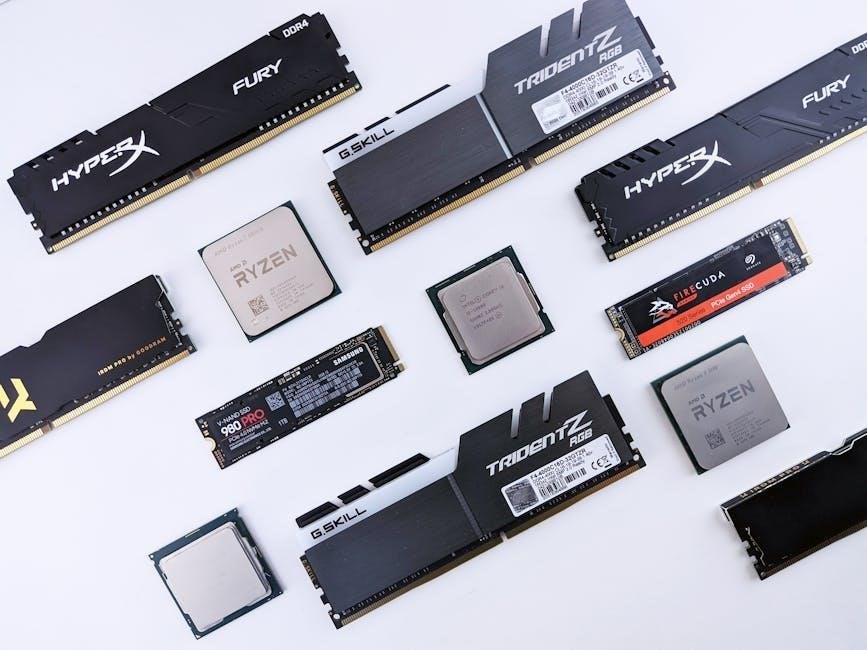
G and M codes are fundamental programming languages for CNC machines, controlling operations like positioning, machining, and tool changes. They ensure precise execution of manufacturing tasks efficiently.
Overview of G and M Codes in CNC Programming
G and M codes are standardized programming languages used in CNC machining to control machine operations. G codes define movements, while M codes manage auxiliary functions like tool changes. Together, they enable precise control over CNC machines, ensuring accurate execution of manufacturing tasks. These codes are essential for programming milling, turning, and other operations, providing a universal language for CNC systems. Understanding G and M codes is crucial for efficient and error-free machining processes.
Structure of G and M Codes
G and M codes follow a specific syntax, using letters and numbers to define operations. Codes are structured in blocks, with parameters added for precise control of CNC machines.
Syntax and Addressing Format
G and M codes use a structured syntax, with codes followed by parameters. For example, G01 X10 Y20 F100 defines a linear move to coordinates X10, Y20 at feed rate 100. Letters like X, Y, Z, F, S, and T specify parameters. Codes are executed sequentially, with optional parameters. M codes, like M03 S1200, control spindle speed. The format ensures clarity and precision, enabling CNC machines to interpret commands accurately. Proper syntax is crucial for error-free machining operations. Examples like G02 for circular interpolation and M08 for coolant activation demonstrate the system’s versatility.
Examples of Common G and M Code Syntax
Common G codes include G00 for rapid positioning and G01 for linear interpolation. For example, G01 X50 Y30 F100 moves the tool to X50mm, Y30mm at 100mm/min. M codes like M03 S1200 start the spindle clockwise at 1200 RPM, while M08 activates coolant. These examples illustrate how codes and parameters combine to execute precise machining operations. Understanding these syntax examples is essential for effective CNC programming and achieving desired outcomes in manufacturing processes.

Categories of G Codes
G codes are categorized into groups based on their functions, such as positioning, interpolation, plane selection, and units. Each category serves distinct machining operations.
G Codes for Positioning and Movement
G codes for positioning and movement control the CNC machine’s motion. Common codes include G00 for rapid positioning, G01 for linear interpolation, and G02/G03 for circular interpolation. These codes define the tool’s path, ensuring precise movements. G00 moves the tool quickly to a location without cutting, while G01 executes cutting moves at a specified feed rate. G02 and G03 enable clockwise and counterclockwise circular motions, respectively. These codes are essential for accurate machining and are widely used in CNC programming.
G Codes for Interpolation and Machining
G codes for interpolation and machining enable complex cutting operations. G02 and G03 handle circular interpolation, clockwise and counterclockwise, respectively. G41 and G42 manage cutter radius compensation, ensuring precise tool positioning. G76 facilitates threading operations, while G17, G18, and G19 set the plane for machining. These codes are vital for executing intricate cuts, ensuring accuracy and efficiency in CNC machining. They are widely used in milling and turning operations to achieve high-quality finishes and precise dimensional control, making them essential for advanced manufacturing tasks.
G Codes for Plane Selection and Units
G codes for plane selection and units are essential for defining the coordinate system and measurement units in CNC machining. G17 selects the XY-plane, G18 selects the XZ-plane, and G19 selects the YZ-plane, ensuring proper tool orientation. G20 sets units to inches, while G21 sets them to millimeters, preventing dimensional errors. These codes are crucial for maintaining precision and consistency in machining operations, ensuring accurate part production and machine functionality.

Modal and Non-Modal Codes
Modal codes remain active until changed, while non-modal codes execute once. They are fundamental for controlling CNC operations, ensuring precise command execution and machine functionality.
Understanding Modal G and M Codes
Modal G and M codes remain active until explicitly changed, allowing for efficient CNC programming. These codes define machine actions, such as movement, tool changes, and spindle control. Common modal G codes include G00 (rapid positioning) and G01 (linear interpolation), while M codes like M03 (spindle clockwise) and M06 (tool change) are also modal. Understanding modal codes is crucial for optimizing CNC programs, ensuring precise and efficient machining operations.
Examples of Non-Modal G and M Codes
Non-modal G and M codes execute once and do not remain active. Examples include G04 (dwell), G53 (absolute positioning), and M00 (program pause). These codes perform specific tasks without affecting subsequent operations, offering precise control over CNC machine actions. They are essential for adding pauses, changing tools, or executing one-time commands, ensuring flexibility and accuracy in machining processes.

Applications of G and M Codes
G and M codes are widely used in milling and turning operations, enabling precise control over tool movements, spindle speeds, and machining processes. They optimize manufacturing tasks efficiently.
G and M Codes in Milling Operations
G and M codes are essential for controlling milling operations, enabling precise tool movements and machining processes. G codes like G00, G01, and G02 control rapid positioning, linear interpolation, and circular interpolation. M codes such as M03 and M08 manage spindle rotation and coolant activation. These codes ensure accurate execution of milling tasks, from simple drilling to complex 3D profiling. Proper use enhances productivity and part quality in milling applications.
G and M Codes in Turning Operations
G and M codes are critical in turning operations, controlling lathe functions like spindle rotation and tool movements. G codes such as G32 handle threading, while G00 and G01 manage rapid and linear movements. M codes like M03 and M04 control spindle direction and speed, ensuring precise material removal. These codes optimize turning tasks, from simple facing to complex profiling, enhancing productivity and part accuracy in CNC lathe operations.
Standards and Variations
G and M codes are based on ISO standards, providing a universal language for CNC machines.
Variations exist across manufacturers, tailoring functionalities for specific machine types.
ISO Standards for G and M Codes
ISO standards establish a universal framework for G and M codes, ensuring compatibility across CNC systems. These standards define code structures, functions, and modal operations, promoting consistency. Key aspects include geometry definitions, motion commands, and tool management. Compliance with ISO standards minimizes variations, facilitating smoother integration and programming. They also cover error handling and parameter settings, ensuring reliable performance. Adherence to these standards is crucial for manufacturers worldwide.
Machine-Specific Variations and Dialects
Machine-specific variations and dialects of G and M codes arise due to differences in CNC systems and manufacturers. While ISO standards provide a base, many machines implement custom codes. For instance, codes like G54 for work offsets may function differently across brands. Additionally, some controllers add unique commands for specialized operations. These variations require programmers to consult specific machine manuals. Understanding these nuances is essential for compatibility and accurate program execution across diverse CNC platforms.

Common G and M Codes Reference
This section provides a comprehensive reference of common G and M codes, detailing their functions and applications. Examples include G00 (rapid positioning) and M03 (spindle clockwise), serving as a guide for CNC programmers to understand standard commands.
Table of Common G Codes and Functions
A table outlining common G codes and their functions is essential for CNC programming. G00 enables rapid positioning, while G01 performs linear interpolation. G02 and G03 handle circular interpolation in clockwise and counterclockwise directions. G17 selects the XY-plane, and G21 sets units to millimeters. These codes are standardized but may vary slightly by machine manufacturer, ensuring precise control over machining operations and tool movements, which is crucial for achieving accurate and efficient production results in various CNC applications.
Table of Common M Codes and Functions
A table of common M codes details their functions in CNC programming. M03 and M04 control spindle rotation (clockwise and counterclockwise). M06 executes tool changes, while M08 and M09 manage coolant activation and deactivation. M30 handles file endings and pallet changes. These codes are standardized but may vary by manufacturer, ensuring precise control over machine actions like tool changes, spindle operations, and coolant management, which are critical for efficient and safe CNC machining processes across various applications.
Best Practices for Using G and M Codes
Always validate G and M code programs before machining. Use simulation tools to ensure accuracy. Maintain consistent formatting and comments for readability. Regularly update knowledge on machine-specific codes to adapt to new technologies and optimize performance.
Programming Tips for G and M Codes
When writing G and M code programs, prioritize clarity by using comments and structured formatting. Always simulate programs before machining to detect errors. Use modal codes strategically to minimize repetitive commands. Avoid combining conflicting G and M codes in the same block. Test programs in a safe environment, such as manual data input (MDI) mode, before running them in auto mode. Regularly review machine-specific manuals to ensure compatibility with your equipment. Update your knowledge of new codes and features to stay efficient and avoid outdated practices.
Common Errors and Troubleshooting
Common errors in G and M code programming include incorrect code addressing, mismatched units (inch/mm), and improper use of modal codes. Ensure all codes are compatible with your machine’s specific dialect. Address alarm codes promptly, as they often indicate syntax or logical errors. Verify tool offsets and workpiece coordinates before running programs. Use simulation software to visually detect issues like incorrect interpolation or axis limits. Always refer to machine manuals for code-specific troubleshooting guides to resolve issues efficiently and safely.